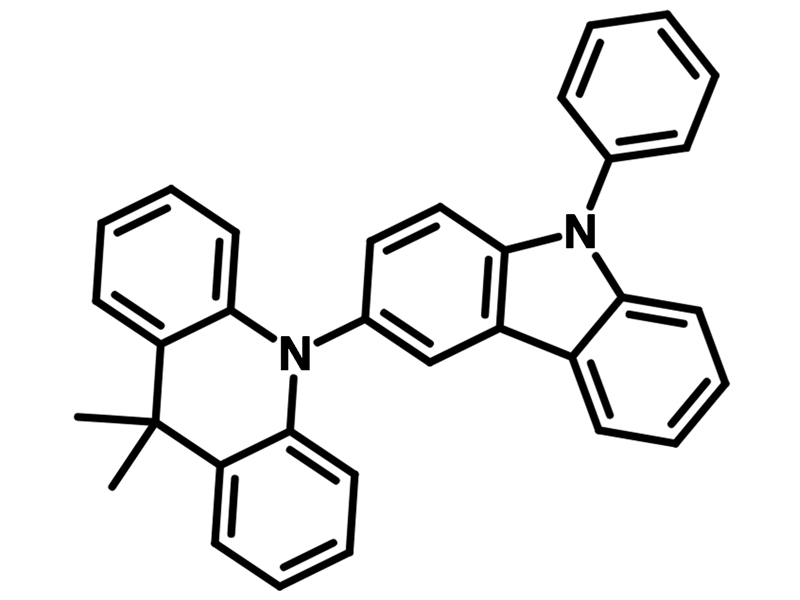PCzAc
CAS Number 1705584-08-2
Charge Transport Layer Materials, High Purity Sublimed Materials, Hole Transport Layer Materials, Host Materials, Materials, OLED Materials,An Acridine-Carbazole Material
Serves as a host material, hole transport, and electron blocking layer in OLEDs and TADF-OLEDs, 9,10-Dihydro-9,9-dimethyl-10-(9-phenyl-9H-carbazol-3-yl)-acridine, PCzAc, CAS No. 1705584-08-2
9,10-Dihydro-9,9-dimethyl-10-(9-phenyl-9H-carbazol-3-yl)-acridine is a dihydroacridine derivative, also known as PCzAc (CAS number 1705584-08-2).
The dihydroacridine is coupled with 9-phenyl-carbazole, having a high triplet energy of 2.99 eV and a high phase transition temperature of 101 °C. PCzAc exhibits a shallow HOMO level due to the acridine unit.
It is suitable for hole injection between an aromatic amine-type hole transport material and a carbazole-type host material. When it is used as a hole transport material, PCzAc increases the hole density, confines carriers, and broadens the emission zone in the emitting layer. As a result, it improves the lifetime of OLEDs.
PCzAc is also valuable for the development of host materials for europium Eu(II)-based blue spin coated OLEDs, owing to its excellent hole transport properties. The solution-processed OLEDs demonstrate high photoluminescence quantum yields of up to 75%.
Transport layer material
increases hole density, confines charge carriers, & broadens emission zone
Improve lifetime of OLEDs
High glass transition temperature of 101°C
Worldwide shipping
Quick and reliable shipping
Sublimed grade purity
>99% Grade purity
General Information
| CAS Number | 1705584-08-2 |
|---|---|
| Full Name | 9,9-Dimethyl-10-(9-phenyl-9H-carbazol-3-yl)-9,10-dihydroacridine |
| Chemical Formula | C33H26N2 |
| Molecular Weight | 450.57 g/mol |
| Purity | Sublimed >99% (HPLC) |
| HOMO/LUMO |
HOMO = −5.7 eV LUMO = −2.4 eV [1] |
| Processing Solvents | Toluene |
| Appearance | White to off-white powder |
| Synonyms | PCzAc |
| Classification or Family | Electron blocking layers (EBL), Host materials, TADF, Hole transport layers (HTL), OLEDs, Sublimed materials |
Chemical Structure

Device Structure(s)
| Device Structure | ITO (50 nm)/HATCN (7 nm)/PCBBiF (70 nm)/PCzAC (10 nm)/DIC-TRZ:10% 12BTCzTPN/DIC-TRZ:10% 12BTCzTPN (7 nm)/DBP (0.6 nm)/DIC-TRZ:10%12BTCzTPN (23 nm)/DDBFT (5 nm)/BPPB: Liq (60 nm)/LiF (1.5 nm)/Al (100 nm) [1] |
|---|---|
| Colour |
|
| External Quantum Efficiency | 17% |
| Lifetime | LT95 = 370 h at 5000 cd/m2 |
| Turn on Voltage | 2.6 V |
| Device Structure | ITO/PEDOT:PSS (40 nm)/PVK (50 nm)/PCzAc:Eu2(L3)2I4(11 wt%, 60 nm)/TmPyPB (40 nm)/LiF (0.7 nm)/Al [3] |
|---|---|
| Colour |
|
| External Quantum Efficiency | 9.2% |
| Current Efficiency | 12.9 cd/A |
| Turn On Voltage | 9.6 V |
*For chemical structure information, please refer to the cited references.
MSDS Documentation
Pricing
| Product Code | Quantity | Price |
|---|---|---|
| M2434A1 | 250 mg | £100 |
| M2434A1 | 500 mg | £180 |
| M2434A1 | 1 g | £325 |
Literature and Reviews
- Stable thermally activated delayed fluorescence sensitized red fluorescent devices through physical supression of Dexter energy transfer, C. Jeon et al., Adv. Mater. Interfaces, 10, 2300147 (2023); DOI: 10.1002/admi.202300147.
- Electroplex as a new concept of universal host for improved efficiency and lifetime in red, yellow, green, and blue phosphorescent organic light-emitting diodes, W. Song et al., Adv. Sci., 5, 1700608 (2018); DOI: 10.1002/advs.201700608.
- Europium (II) complexes with substituted tris(2-aminoethyl)amine/triethanolamine ligands and their application in blue spin-coated organic light-emitting diodes, A. Wu et al., Adv. Optical Mater., 10, 2200952 (2022); DOI: 10.1002/adom.202200952.

 PCzAc MSDS Sheet
PCzAc MSDS Sheet